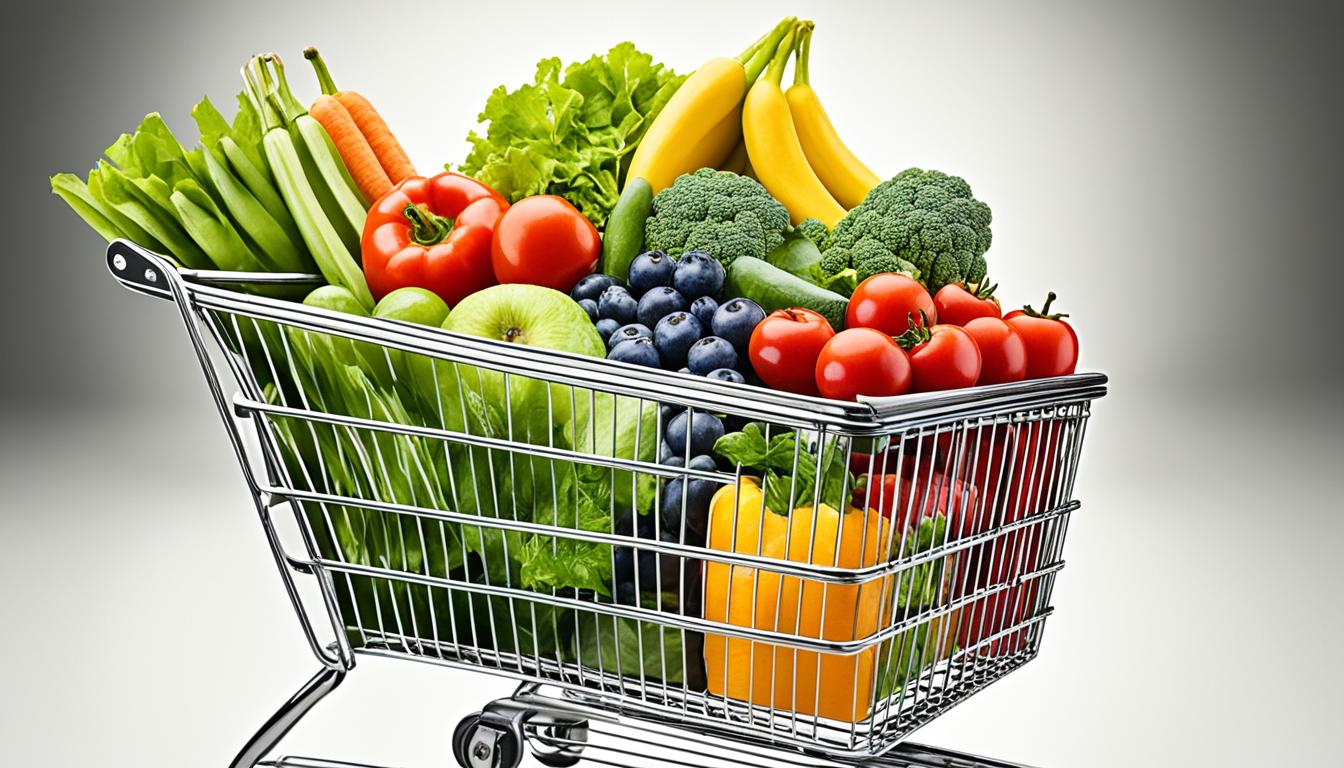Did you know that healthy food can cost twice as much as less healthy options? Yes, it’s true. When you choose to eat well, it can really stretch your budget. So what makes healthy food so costly?
Understanding why healthy food is expensive isn’t simple. It touches on health impacts and economic hurdles that millions face. Factors like marketing and the cost of getting food to stores play big roles in food prices.
Key Takeaways:
- Healthy food often costs more, making it hard for people to eat well.
- High prices for healthy foods are tied to marketing and consumer demand for wellness products.
- Fresh produce, fish, and meat have extra costs like cooling and restocking, which consumers end up paying for.
- Things like not enough workers, rising prices, and how much people want these foods can also make healthy food expensive.
- To make nutritious food cheaper, policies like food subsidies and changing food formulas are needed.
The Disparity in Food Prices
Research shows a big gap in the cost of eating healthy versus unhealthy. Healthy foods often cost twice as much as unhealthy ones per calorie. This makes it hard for families with less money to buy good, nutritious food. They might end up picking cheaper, processed food instead.
Fresh fruits and vegetables show this cost gap clearly. Their prices are higher because getting them to stores is more complex and expensive. Costs like transportation and cooling get added to the price. So, these important foods become harder for many to afford.
To help people afford healthy meals, several strategies can work. Budget-friendly meal planning is one. It means shopping smart, using everything you buy, and cutting down on waste. By planning this way, people can eat well without spending too much.
Choosing frozen vegetables is another smart move. They’re frozen when very fresh, so they keep their goodness. Plus, they’re cheaper, making it easier to eat healthy foods all year.
Tips for Cheaper Nutritious Meals:
- Buy in bulk: Get staples like grains and spices in big amounts to save cash.
- Visit local farmers markets: They often have fresh, local food at better prices than regular stores.
- Grow your own: If you can, grow fruits, veggies, and herbs. It’s a cheap way to get fresh food.
- Opt for seasonal produce: Foods in season are usually cheaper and plentiful. Use them in your meals to cut costs.
- Plan meals around sales: Look for grocery sales or online deals. Then buy nutritious foods at lower prices.
With these smart shopping tips, anyone can beat the high cost of healthy eating. Even with financial limits, making better food choices is doable. Healthy eating doesn’t have to break the bank.
Labor Shortages and Farming Challenges
In many countries like Europe and the US, the number of farm workers is dropping. This drop is shaking up the food supply chain. Labor shortages affect food production and costs, which then impacts people’s health and wellness.
In the UK, farms lost millions of pounds worth of fruits and vegetables because there weren’t enough workers. Crops go unpicked, causing farmers to lose money. This also means less fresh, healthy food is available for people to buy.
One idea to help with worker shortages is using more machines in farming. But, this solution is not simple. It requires a lot of money for equipment and changes. These costs could make food prices go up, making it hard for many people to afford.
The food supply chain is also at risk from unpredictable weather, like floods and heatwaves. These conditions can hurt crop yields and increase costs for moving food around. So, food can become more expensive and less varied, making it hard to find good food options.
Basically, not having enough farm workers and facing farming troubles makes it hard to get and afford food. This situation can harm people’s health. Finding new ways to farm, using technology, and investing in agriculture can help fix these issues. This way, we can ensure everyone has access to enough food.

The Global Impact of Food Prices
Healthy food has become more expensive everywhere. This affects billions who can’t buy what they need to eat well. The weather and climate change play big roles in pushing food prices up. This makes it hard for families to keep a healthy diet.
Research shows about 3.14 billion people worldwide can’t get the food for a good diet. This makes a big gap in who can eat healthily. When food costs a lot, people’s health gets worse. Obesity rates go up, showing we need to do something now.
In the UK, climate changes caused 60% of the food price hikes in households. This connects food prices to climate changes and bad weather. Such events are happening more often. They hurt our food supply and make prices go up, which makes it hard for everyone.
To show how urgent this is, see this table. It shows how much climate change costs us in food bills:
| Country | Percentage of Household Bills Attributed to Climate-Related Costs |
|---|---|
| United Kingdom | 60% |
| United States | 45% |
| Australia | 53% |
| Canada | 58% |
These numbers tell us we need to act fast on climate change. We need a global effort to handle this crisis. Doing so will help people’s health and keep our food systems strong.
The picture here shows how food prices affect us worldwide. It shows we are all connected in facing this challenge:

The crisis in food prices is a big hurdle for better public health and diet. We must come up with plans that focus on being sustainable and fair. Everyone should have access to nutritious food.
Policy Solutions for Affordability
Making healthy food affordable is essential. This means finding ways to help everyone buy nutritious foods easily. There are two main actions to take:
- Subsidies on fruits and vegetables: The government can lower fruit and veggie prices with subsidies. This helps consumers afford them easier. It also encourages farmers to grow more, which can decrease prices further. By doing this, nutritious foods become easier for all families to include in their meals.
- Reformulating products: Companies can also make healthier food more affordable. They can do this by changing their recipes and how they make food. Healthier foods can then be sold at better prices. This lets people choose healthier options without spending more money.
Apart from these steps, other actions can help too. Governments can teach people about eating right and how food affects the environment. With enough knowledge, people can make smarter choices about what they eat.
To make nutritious foods affordable, everyone needs to work together. Governments, companies, and individuals play a part in this. By taking these actions, we can make sure healthy diets are within reach for everyone.

The Importance of Access to Nutritious Food
The cost of healthy eating is high, creating economic barriers. This leads to food insecurity for many. In Massachusetts, one out of three people struggles with food insecurity because food prices affect their health.
Food insecurity impacts not just how much food people have, but also their health. Those facing food insecurity are more likely to suffer from anxiety, depression, diabetes, and obesity. The main reason is they can’t afford nutritious food.
Community resources are key to promoting healthier eating. Food banks, for instance, are essential. They provide nutritious food to those who need it most. Food banks focus on the nutritional value of the food they give out. This helps improve the health of the community.
“Food banks play a crucial role in increasing access to nutritious food for individuals regardless of their buying power.”
Food banks work with local farms, supermarkets, and food manufacturers. They get fresh fruits, vegetables, whole grains, and lean proteins. This effort makes sure people and families get the nutrients they need.
Besides food banks, there are other community resources. Like community gardens, farmers’ markets, and food co-ops. They provide more chances for people to find affordable, nutritious food. These efforts not only make more food available, they also encourage people to be more involved in their health.
It’s important to fight the economic barriers to healthy eating. We need to make nutritious food more accessible. By supporting community resources, people can face the effects of food prices on their health. This leads to better nutrition for everyone.
Conclusion
Eating healthy can be expensive, making it tough for many families to keep up. But, there are ways to make healthy eating more affordable. By exploring these options, everyone can enjoy nutritious meals without breaking the bank.
Planning meals on a budget is a smart move. It means deciding what to eat ahead of time and buying just what you need. Choosing less costly, nutritious foods lets you stretch your food dollar and eat well. Also, using frozen veggies is a great way to save money and still get your vitamins and minerals.
Community resources can also help make healthy food more affordable. Food banks and local groups often give out fresh produce and healthy foods for low cost or free. These services make it easier for people to eat well without spending a lot of money.
Changes in policy could make nutritious food cheaper too. If the government helped lower prices on fruits and veggies, more people could afford them. Also, if food companies made their products healthier and more budget-friendly, it would be a big help.
We need to tackle the high cost of healthy food head-on. Finding practical ways to make nutritious eating more budget-friendly is key. Doing so is crucial for improving health and building a healthier future for everyone.




